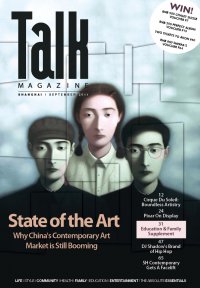Hung Liu Gives History New Life

As one of China's foremost female contemporary artists, Hung Liu has made a name for herself as a creator of large, dripping and emotionally-charged paintings based on old Chinese photographs. Her solo exhibition Concession is currently on display at the Elisabeth de Brabrant Art Center.
As an artist who is both Chinese and female, Hung Liu has always been the quintessential outsider, and after 25 years living in the United States, her experience of emigration and immigration only adds to her unique outside-in perspective of China's people, history and mythology.
“I never really left China emotionally or conceptually, because my subject matter is still China. For that reason, I do not have a lot of shows in China but I feel that even though years have passed, China is still part of the fabric of my work. I feel I am still connected,” the 63 year old painter explains.
Hung came of age during the Cultural Revolution and was sent to the countryside for re-education as a teenager. She maintains strong memories of the burning books and family photographs that were hallmarks of that turbulent era. After arriving in the US in 1984, Hung discovered surviving historical photographs of her homeland that had been smuggled to safety and felt compelled to give new life to the stories they depicted.
 “I wanted to make these images six feet tall, to discover for myself what was underneath the layers,” she says. “It's like excavation. Of course, I could never discover the whole story, but it is a great process. And in the end, more questions are raised than answers.”
“I wanted to make these images six feet tall, to discover for myself what was underneath the layers,” she says. “It's like excavation. Of course, I could never discover the whole story, but it is a great process. And in the end, more questions are raised than answers.”
Most commonly depicting Chinese women, the subjects these photographs have preserved appeal directly to Hung's sense of historical gender representation. In her view, Chinese history portrays two kinds of women: the worker and soldier women who take charge of their destinies and women who fill the needs of men – decorative, pretty and lacking in their own identity.
“I am interested in the contrast between these two kinds of women,” Hung says. “So, in my work, I want to restore dignity to the second kind. [Allow them to] return the male gaze in a more aggressive, strong, dignified way. Give them back the ability to be human again.”
Hung admits that critics have described her work as 'copying' or 'cheating' because the images she uses originate in photographs captured by other people, but she explains her style as a reaction to her Social Realist art education, the dominant methodology in the China of her youth. Despite the style's 'realist' moniker, Hung says the heroically posing warriors and smiling, mud-encrusted peasants of Social Realism are in actual fact ‘pseudo-realism’. Hung says her aim was always to bring something more than just a pretty picture to the table.
“Real freedom is allowing yourself to open up no matter what your inspiration,” she explains. “I'm inspired by photography, but I see it closer to reality. Seeing it this way, it's not about copying, not about imitating nature or the image. It's about re-creating – and creating. Giving new life to old photography. Turning old photographs into new paintings.”
Even the name of the current show, Concession, puts a new twist on a historic term. The former French Concession where Hung's works are currently being shown is emblematic of a period of time in which China made concessions to accommodate international settlement. There is also the constant battle against concession for artists attempting to keep their vision pure, and Hung says she is also referencing the compromises women have made throughout history.
“There are always temporal, spatial and emotional concessions being made,” Hung says. “The subjects of my art are primarily women, and particularly women from feudal society. I think of women as constantly making concessions. This idea ties in with the history of China, and especially the history of Shanghai.”


